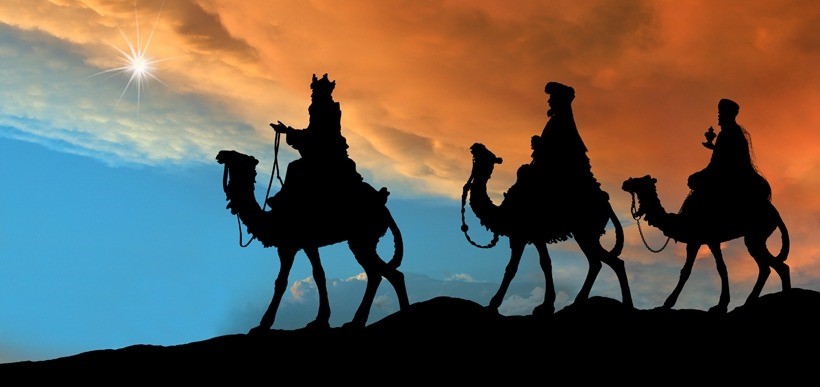
At the feast of the Epiphany two Sundays ago, I started to give some serious thought to the ‘Three Kings’ while we were singing We Three Kings of Orient Are, one of my favorite Christmas carols. Who exactly were they? And why would they ‘travel afar?’
Celebrating the Epiphany In Duke Chapel, many years ago, the Reverend Peter J. Gomes, an old and dear friend, introduced his homily on the Three Wise Men by saying he had a lot in common with them: he was always late. So is this post!
Contrary to popular Christmas tradition, the Bible does not use the terms “three wise men” or “three kings” to describe the travelers who went to see Jesus after his birth. (See Matthew 2:1). Instead, Matthew used the Greek word ma’goi to describe those who visited Jesus, that is, one of a learned and priestly class. The word likely refers to experts in astrology and other occult practices. A number of Bible translations call them “astrologers” or “magi
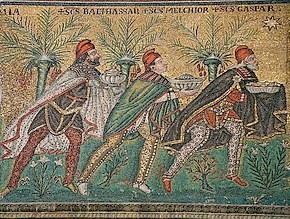
The Three Magi, Byzantine mosaic, c. 565, Basilica of Sant’ Appolinare Nuovo, Ravena, Italy (restored during the 19th century). As here, Byzantine art usually depicts the Magi in Persian clothing, which includes breeches, capes, and Phrygian caps.
Herodotus, a Greek historian of the fifth century B.C.E., said that the ma’goi of his day belonged to a Median (Persian) tribe that specialized in astrology and interpretation of dreams. Eastern tradition sets the number of Magi at 12, but Western tradition sets their number at three, probably based on the three gifts of ‘gold, frankincense, and myrrh.’ Attempts to give them names over the centuries settled on Gaspar, Melchior, and Balthasar, based on Melkon, King of Persia; Gaspar, King of India; and Baldassar, King of Arabia.
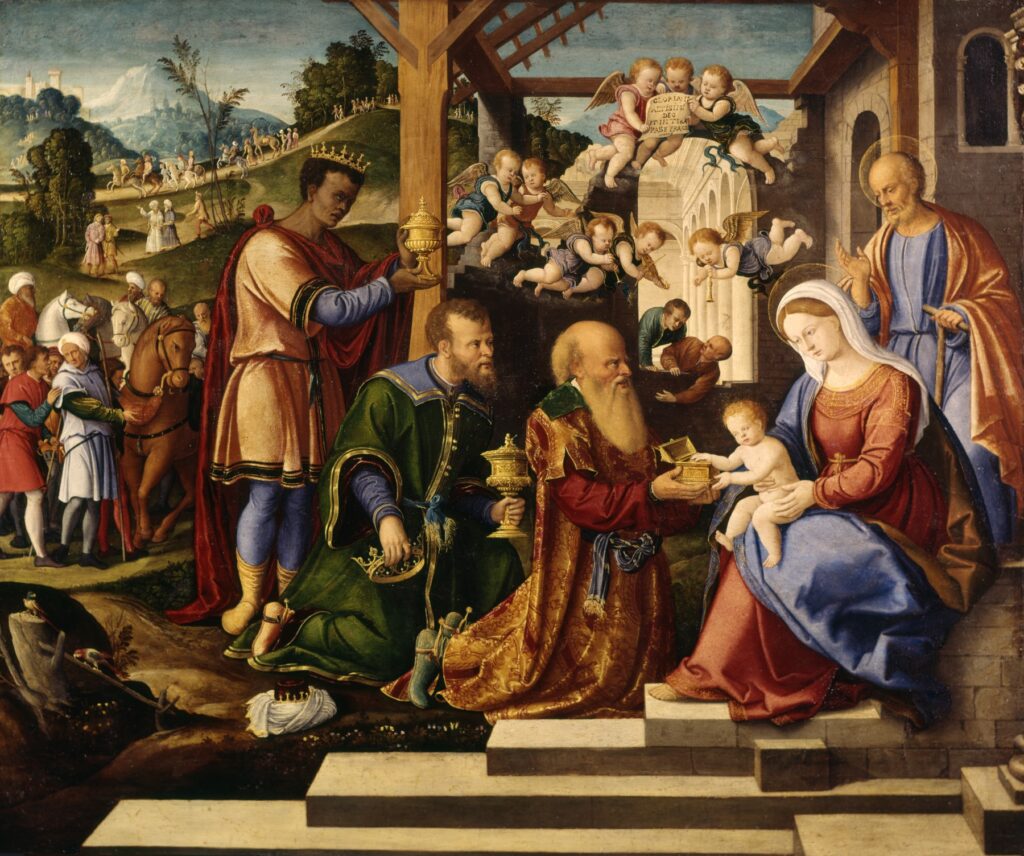
Girolamo da Santacroce (Italian, 1480-1556) ca. 1525-1530 (Renaissance)
Where did they come from? Possible the Parthian Empire in Iran (then Persia), which stretched from eastern Syria to the fringes of India and which was tolerant of other religions. Its dominant religion was Zoroastrian with its priestly ma’goi class. Zoroastrianism is one of the world’s oldest monotheistic religions, having originated in ancient Persia. It contains both monotheistic and dualistic elements, and many scholars believe Zoroastrianism influenced the belief systems of Judaism, Christianity, and Islam. Although Matthew’s account does not explicitly cite the motivation for their journey, the Syrian Infancy Gospel states that they were pursuing a prophecy from their prophet, Zoroaster.
Another possibility of their origin is that they were Nabataean wise men from the courts of King Aretas IV (ca. 9 BC – AD 40). Nabataeans no doubt had a significant grasp of astronomy and used it for directions when they traveled by night. A new star would have caught their attention. The Nabataeans were renowned traders, who amassed great wealth by controlling many of the trade routes from Arabia through their capital of Petra and onto the coastal port of Gaza.
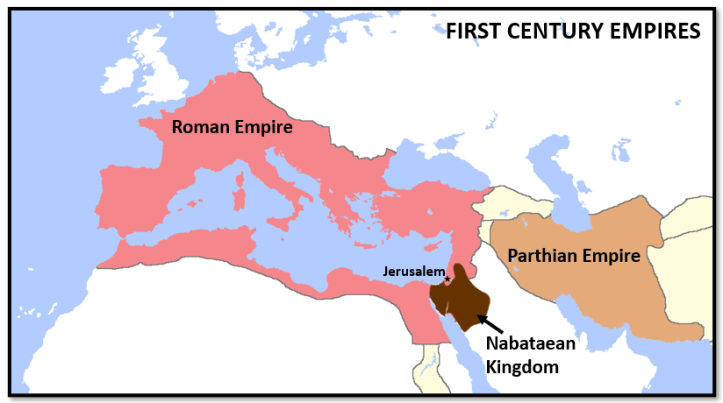
Regardless of their origin, it is generally accepted that they followed a star. But was it a star? The fact that they needed to ask Herod for directions when they arrived suggests they were not being led to their final destination by a single bright object. If not a star, then what? The other, more astronomical, explanation is that there was indeed a bright object in the sky — a conjunction between planets and stars. A conjunction occurs when two or more celestial bodies appear to meet in the night sky and these events can continue every night in a similar location for days or weeks. If the wise men were to follow the moment of conjunction, it’s possible they would have been led in a specific direction.
Perhaps the most promising is an alignment of Jupiter, Saturn, the moon and the sun in the constellation of Aries on April 17, 6 B.C. This conjunction happened in the early morning hours, which aligns with the Gospel’s description of the Star of Bethlehem as a rising morning star.
Matthew records the visit of the Wise Men to Bethlehem, but before they arrived there, they met with Herod, the Roman-appointed king of Judea, a man who was the center of political and family intrigues in his later years. The New Testament portrays him as a tyrant. When the wise men asked him, “Where is he who has been born king of the Jews? For we saw his star when it rose and have come to worship him” (Matthew 2:1-2), pretended not to know what they spoke of.
Herod was frightened by the apparent fulfillment of a messianic prophecy that threatened his rule, , so he sent them to Bethlehem, saying, “Go and search diligently for the child; and when you have found him, bring me word so that I may also go and pay him homage.”
After hearing from Herod, they set out, following the star they had seen at its rising, until it stopped over the place where the child was. Thankfully, the magi were warned in a dream not to return to Herod, so when they left for their own country, they went by a different way. The Bible says: “Herod, seeing that he had been outwitted by the astrologers, flew into a great rage, and he sent out and had all the boys in Bethlehem and in all its districts killed, from two years of age and under, according to the time that he had carefully ascertained from the astrologers.”
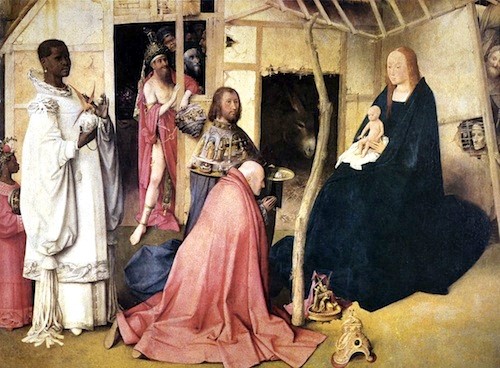
Adoration Of the Magi—Hieronymus Bosch (c. 1450-1516)
Massacre (or Slaughter) of the Innocents is also recounted by (2:16–18), with thousands of deaths recorded by various historians, However, modern scholarship finds no evidence that it happened outside of Matthew’s description, though it is believable given Herod’s character.
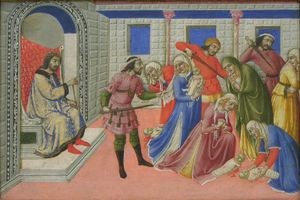
The Massacre of the Innocents, tempera on wood painting by Sano di Pietro (Ansano di Pietro di Mencio), c. 1470; in the collection of the Metropolitan Museum of Art.
There are so many things about the story of the three Wise Men that confound explanation, so perhaps it is best to leave their story as a miracle.
![]()

Here, in Spain, we celebrate Epiphany and children receive their presents that day (although now, many get presents for Christmas as well). Thanks for all the information, Noelle. (We usually call them Los tres Reyes Magos de Oriente)
Yes, thanks Noelle. An interesting post.
Thanks, Rosie.
It is an interesting post, but I don’t get the title, though. Were they late?
For several years now I’ve been fretting at the ‘they saw the star in the east and found him in a stable.’
Why were they travelling east? Bethlehem must have been west from where they came from.
And I thought one of the star theories was a supernova, possibly now the crab nebula in Taurus or the Orion nebula (close by). Both would be in the east in the early part of the evening in winter.
But I’m never much good at checking my facts. I knew them once, but these days I seem to get muddled.
I read an article by an astronomer that basically laid out why they couldn’t be following a star because it wouldn’t always be in the west, but the conjunction of planets and/or stars fits the bill. I like to do research which is how I found the article! Thanks for stopping by!
Your analysis of the three wise men is so well done, Noelle. I think leaving the story in the miracle class is the best way to conclude it. Thanks for sharing this post.
You’re most welcome, John. Just something I started thinking about in church that Sunday!
It came out of the pew in fine shape.
How nice! I love hearing how other countries celebrate the holiday season. In Prague I was visited in early December by Svaty Nicolas and an angel!
They had hoped to arrive for the birth, but actually didn’t arrive until a month or so later!
Thanks for all the history and speculation around the story of the the Three Magi, Noelle. Religion and the stories that bring it to life are fascinating.
Terrific post, Noelle. Hugs.
Great background on the Wiseman, Noelle. I like the miracle aspect of it, but like you, wonder too.
Even after all the research I read, no one could explain all of it!
This is so interesting, Noelle. Since they were astrologers and dream interpreters, I’d say the alignment of the stars influenced their journey greatly. Thank you for sharing!
🙂 🙂
The Bible has such wonderful stories. I think we forget that it is the most popular book in the world!
Thanks, Jan. I had fun doing a little research on this!
Thanks, Teagan. I would like to have met them!
For all the mystery that surrounds the 3 wise men you tell a most interesting and intriguing story Noelle.
Happy New Year to you and your loved ones. 🙂
Isn’t it intriguing? Makes me want to time travel back and find out what really happened! We cook salmon this weekend!
Your blog is a breath of fresh air in the often stagnant world of online content. Your thoughtful analysis and insightful commentary never fail to leave a lasting impression. Thank you for sharing your wisdom with us. HABANERO88
I’ve been following your blog for some time now, and I’m consistently blown away by the quality of your content. Your ability to tackle complex topics with ease is truly admirable. HABANERO88
Hey there You have done a fantastic job I will certainly digg it and personally recommend to my friends Im confident theyll be benefited from this site
Mitolyn Pretty! This has been a really wonderful post. Many thanks for providing these details.
Tech dae I am truly thankful to the owner of this web site who has shared this fantastic piece of writing at at this place.
Puraburn This is really interesting, You’re a very skilled blogger. I’ve joined your feed and look forward to seeking more of your magnificent post. Also, I’ve shared your site in my social networks!
Fantastic beat I would like to apprentice while you amend your web site how could i subscribe for a blog site The account helped me a acceptable deal I had been a little bit acquainted of this your broadcast offered bright clear concept
Your blog has quickly become one of my favorites. Your writing is both insightful and thought-provoking, and I always come away from your posts feeling inspired. Keep up the phenomenal work!
Puraburn Good post! We will be linking to this partspacelarly great post on our site. Keep up the great writing
Your blog is a breath of fresh air in the often stagnant world of online content. Your thoughtful analysis and insightful commentary never fail to leave a lasting impression. Thank you for sharing your wisdom with us.
Thank you for the auspicious writeup It in fact was a amusement account it Look advanced to far added agreeable from you However how can we communicate